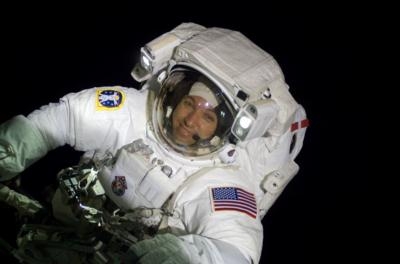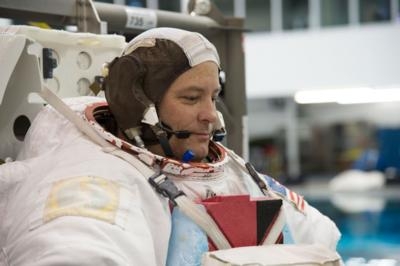A Dozen International Space Travelers Scheduled to Visit The Station
NASA and its International Space Station partners have announced the crew members for missions to the orbiting laboratory in 2017. The selection includes first-time space flyer NASA astronaut Scott Tingle and veteran Randy Bresnik.

“There’s so much going on aboard the space station at this point, so many science experiments and technology demonstrations,” said Chris Cassidy, chief of the Astronaut Office at NASA’s Johnson Space Center in Houston. “Scott and Randy have their work cut out for them, but I have no doubt they’ll do excellent jobs.”
Tingle is a member of NASA’s 2009 astronaut class and will fly with cosmonauts Ivan Vagner, who is also a first-time flier, and veteran Alexander Skvortsov, both of the Russian space agency Roscosmos. They will launch in September 2017. The three will join the station’s Expedition 53 crew of NASA astronaut Jack Fischer, ESA (European Space Agency) astronaut Paolo Nespoli and Roscosmos cosmonaut Fyodor Yurchikhin.
Tingle, a captain in the U.S. Navy, was born in Attleboro, Massachusetts, but considers Randolph, Massachusetts, his home. He was commissioned as a naval officer in 1991 and earned the gold wings of a naval aviator in 1993. He has accumulated more than 4,000 hours in 48 types of aircraft, 700 carrier landings and 54 combat missions.
Tingle earned a bachelor’s degree in mechanical engineering from Southern Massachusetts University in Dartmouth in 1987, and a master’s degree in mechanical engineering, with a specialty in fluid mechanics and propulsion, from Purdue University in West Lafayette, Indiana, in 1988. He also is a 1998 graduate of the Navy Test Pilot School.
Bresnik’s mission will begin in November 2017, when he and his crewmates Sergey Ryazansky of Roscosmos and Norishige Kanai of the Japan Aerospace Exploration Agency (JAXA) will join Tingle, Skvortsov and Vagner on the station for Expedition 54.
Bresnik, who considers Santa Monica, California, to be his hometown, is a retired colonel in the U.S. Marine Corps. Bresnik received his commission in May 1989 and was designated a Marine Corps aviator in 1992. He flew the F/A-18 Hornet in support of Operation Southern Watch and Operation Iraqi Freedom. He has accumulated more than 6,000 hours in 81 types of aircraft.
Bresnik was selected as an astronaut in May 2004. His first spaceflight was in November 2009 aboard space shuttle Atlantis for STS-129, which lasted 11 days. The flight was the 31st shuttle flight to the space station, during which Bresnik conducted two spacewalks totaling 11 hours and 50 minutes.

Bresnik graduated from The Citadel in Charleston, South Carolina, in 1989 with a bachelor’s degree in mathematics, and earned a master’s degree in aviation systems from the University of Tennessee, Knoxville, in 2002. He is also a 2008 graduate of the U.S. Air Force Air War College.
The crew comprising Expedition 53 will be:
- Jack Fischer, NASA
- Paolo Nespoli, ESA
- Fyodor Yurchikin, Roscosmos
- Scott Tingle, NASA
- Alexander Skvortsov, Roscosmos
- Ivan Vagner, Roscosmos
The crew comprising Expedition 54 will be:
- Scott Tingle, NASA
- Alexander Skvortsov, Roscosmos
- Ivan Vagner, Roscosmos
- Randy Bresnik, NASA
- Sergey Ryazansky, Roscosmos
- Norishige Kanai, JAXA
The space station is a convergence of science, technology and human innovation that enables us to demonstrate new technologies and make research breakthroughs not possible on Earth. It has been continuously occupied since November 2000 and, since then, has been visited by more than 200 people and a variety of international and commercial spacecraft. The space station remains the springboard to NASA's next giant leap in exploration, including future missions to an asteroid and Mars.
(Source: NASA news release. Images courtesy of NASA. Top: Randy Bresnik. Bottom: Scott Tingle)
 Airbus Racer Helicopter Demonstrator First Flight Part of Clean Sky 2 Initiative
Airbus Racer Helicopter Demonstrator First Flight Part of Clean Sky 2 Initiative Diamond's Electric DA40 Finds Fans at Dübendorf
Diamond's Electric DA40 Finds Fans at Dübendorf ANN's Daily Aero-Term (04.23.24): Line Up And Wait (LUAW)
ANN's Daily Aero-Term (04.23.24): Line Up And Wait (LUAW) NTSB Final Report: Extra Flugzeugbau GMBH EA300/L
NTSB Final Report: Extra Flugzeugbau GMBH EA300/L Classic Aero-TV: 'Never Give Up' - Advice From Two of FedEx's Female Captains
Classic Aero-TV: 'Never Give Up' - Advice From Two of FedEx's Female Captains




